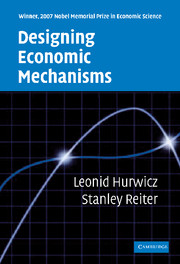3 - Designing Informationally Efficient Mechanisms Using the Language of Sets
Published online by Cambridge University Press: 24 May 2010
Summary
Introduction
This chapter presents a formal and concise account of the process of designing a decentralized mechanism that realizes a given goal function. The presentation here differs from the one in Chapter 2 in that this process is set-theoretic, whereas in Chapter 2 (and Chapter 4), sets and relations are represented by equations. The set-theoretic formulation is more general, and covers cases in which the set of environments is a finite or discrete set. A merit of the set-theoretic formulation is that it helps make clear the essential logic and properties of our procedures for designing decentralized mechanisms. On the other hand, the formulation in which sets and relations are represented by equations permits the components of a mechanism to be expressed in terms of algebraic expressions that hold across the set of environments, rather than pointwise, as is the case with the set-theoretic formulation. The process of mechanism design is “algorithmic” in both formulations, in the sense that the design process consists of a sequence of prescribed steps that starts with a specified goal function, and results in an informationally efficient decentralized mechanism that realizes the given goal function. Both approaches use the axiom of choice to prove the existence of a transversal. However, the equations approach may in specific instances derive a transversal by algebraic means, or through the use of calculus. In the approach that uses smooth equations to characterize sets and functions, an analysis may require solution of systems of nonlinear equations of high degree.
Information
- Type
- Chapter
- Information
- Designing Economic Mechanisms , pp. 182 - 295Publisher: Cambridge University PressPrint publication year: 2006
